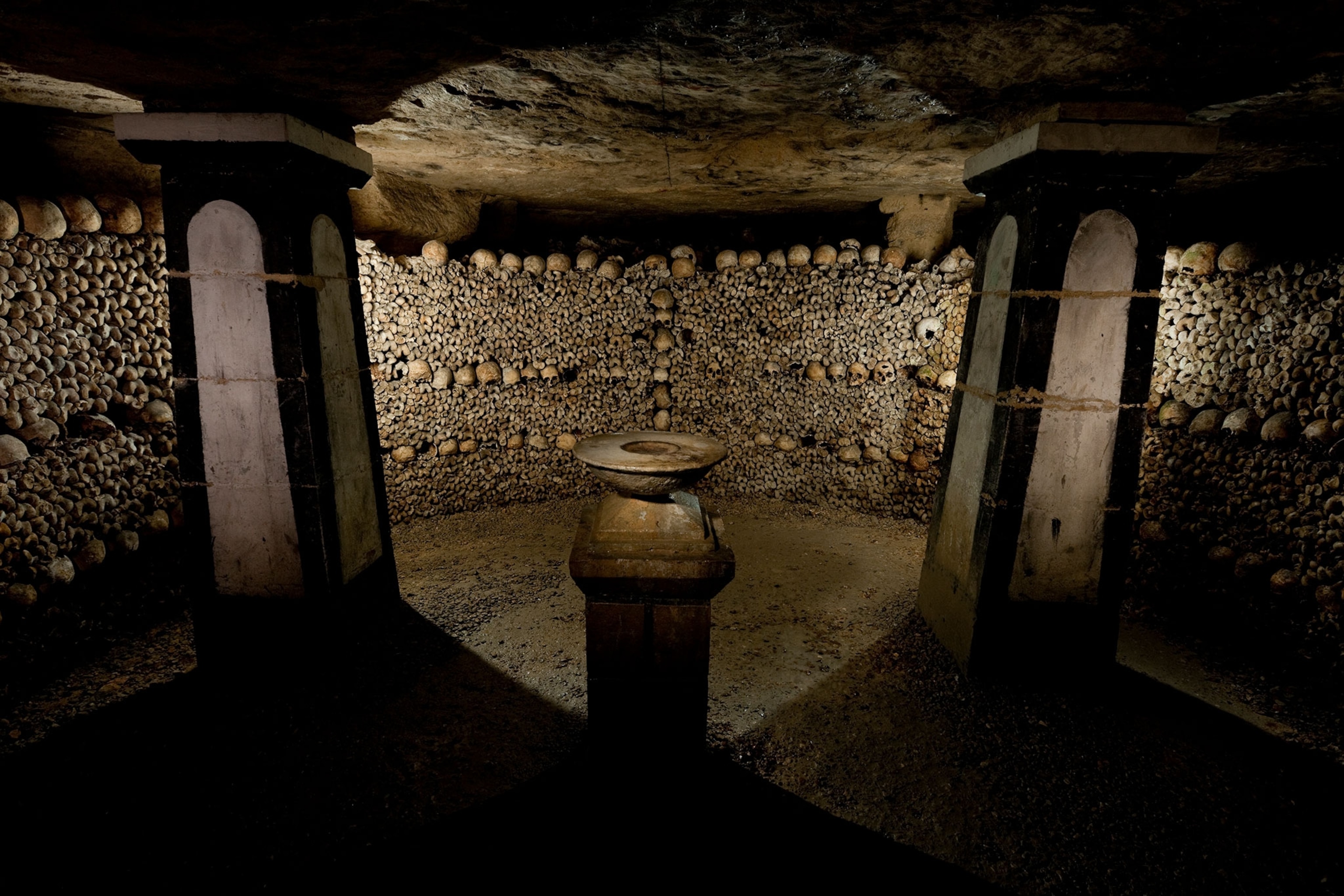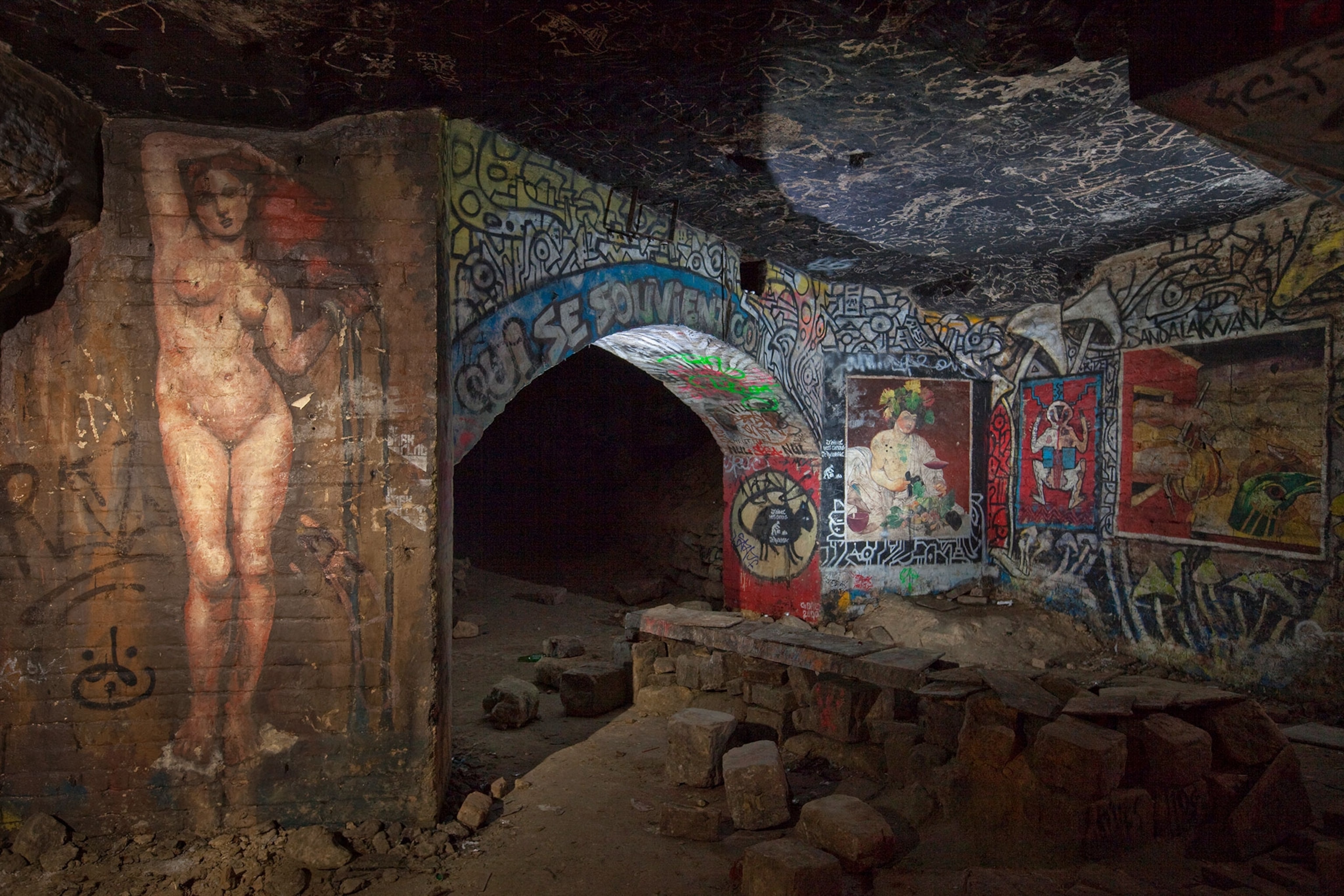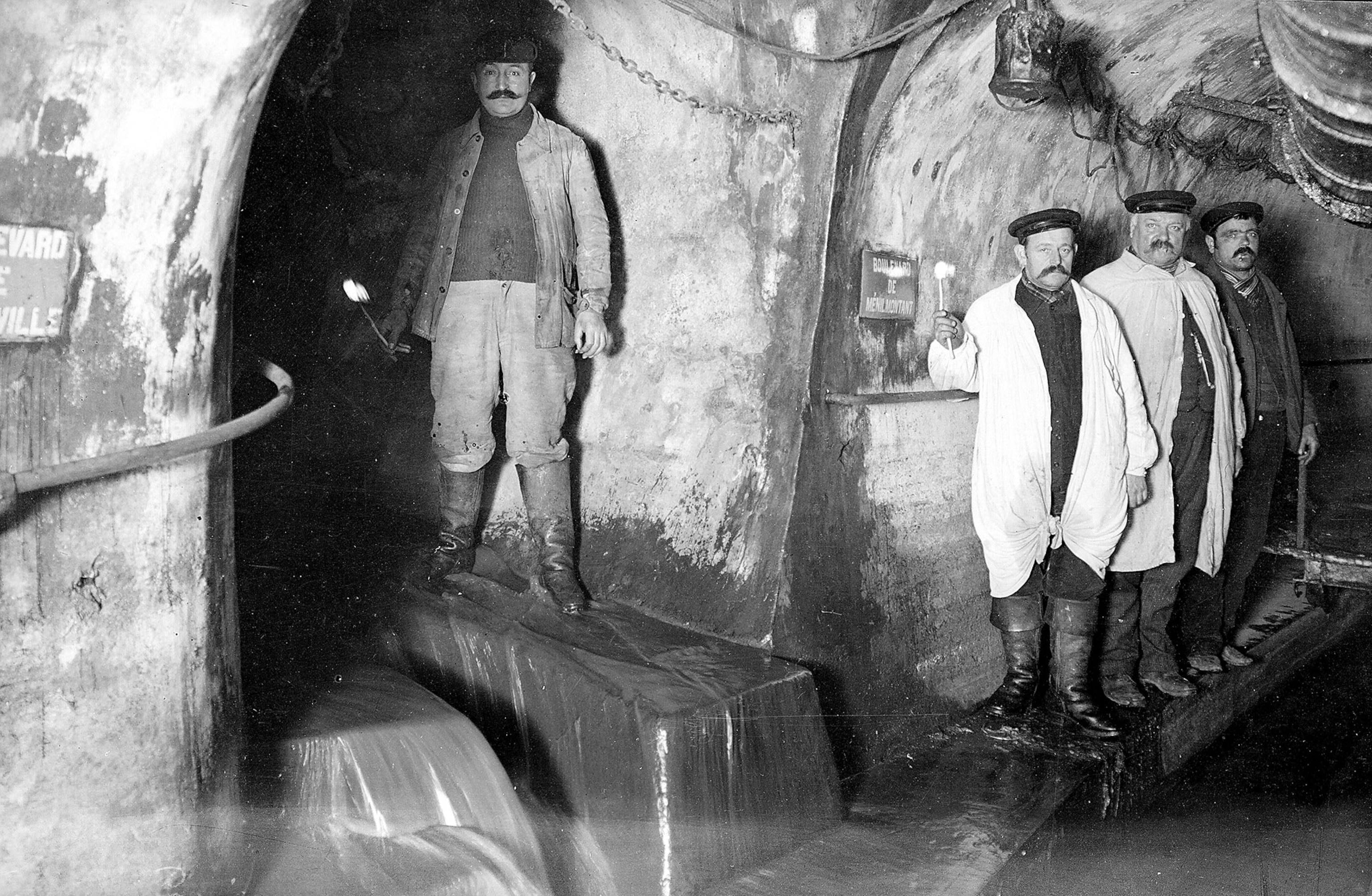
Discover the secret underground world of Paris
From forbidden tunnels to the legendary catacombs, the City of Light harbors a deeper and darker side.
Paris’s fabled monuments, sublime churches, and iconic sites were created from limestone excavated from a vast maze of subterranean quarries, starting in the Middle Ages. Deserted over time, the tunnels stretch nearly 200 miles and are strictly off-limits. Yet so-called cataphiles, or urban explorers, can’t resist the temptation to trespass underground via sidewalk manholes and secret trapdoors.
The stories have become legend: The old quarries, their walls tagged with graffiti, have hosted nocturnal discotheques, illicit art shows, and secret cinemas.
The word “cataphile” takes its name from the catacombs, a portion of the disused quarries housing one of the world’s largest ossuaries. Stretching nearly a mile beneath the 14th arrondissement in southern Paris, the catacombs contain the remains of an estimated six million Parisians. As the only legal place to explore the underground tunnels, it’s a popular tourist attraction.
The origins of Les Catacombes de Paris go back to a dramatic incident in 1774: A sinkhole engulfed houses on a street near present-day Place Denfert-Rochereau. The quarry network below the capital was unstable and at risk of collapse. To avoid further calamity, King Louis XVI appointed architect Charles-Axel Guillaumot Inspector of Quarries to map and secure the galleries in 1777.

‘The empire of death’
A few years later, a macabre spectacle played out on the Rue de la Lingerie. A retaining wall collapsed next to the Cimetière des Innocents, flooding a neighboring cellar with the rotting corpses of a mass grave. In fact, Paris’s largest cemetery—serving as a major burial ground since the 10th century—was overflowing with cadavers.
The city’s unsanitary and overcrowded cemeteries were thereby condemned, and the king ordered new ones to be constructed outside of Paris. The bodies were exhumed and transferred to their new subterranean resting place, inspired by the catacombs of Rome. Underground, the inspector general’s workers organized the skulls, tibias, and femurs into neatly arranged walls. Engraved plaques indicated the cemetery of origin, and the date of the bones’ transfer.

Les Catacombes de Paris did not open to visitors until 1809. The entrance to the necropolis itself is marked with the words: “Arrête! C’est ici l’empire de la mort—Halt! This is the empire of death.” The catacombs were so in vogue that emperors Francis I of Austria and Napoleon III visited, and, in 1897, a large crowd attended an orchestra’s performance of songs such as Frédéric Chopin’s Funeral March.
Become a subscriber and support our award-winning editorial features, videos, photography, and much more.
For as little as $2/mo.
The celebrated photographer Gaspard-Félix Tournachon, known as Nadar, experimented there with the first photographs created with artificial light on a three-month stint in 1861. Scientists conducted research on the flora and fauna thriving in the pitch black; naturalist Armand Viré even discovered troglodytic crustaceans in the tunnels.
“Under suitable conditions, bones can be preserved for a long time. They nevertheless remain fragile,” says Isabelle Knafou, the site’s general administrator. To ensure the site’s sustainability, a large-scale restoration project kicked off in autumn 2023 with a newly imagined visitor experience unveiling in 2026.
(Beneath Paris lies a dark and forbidden world of the dead.)
Street art

Métro marvel
Ascending vertically in the city’s substrata, the Métropolitain subway network has been part and parcel of Parisian life since the first line opened between Neuilly and Vincennes in 1900. It’s not just a fast and efficient public transport system—the city’s exacting residents love to bemoan a wait time longer than four minutes—it’s also a bastion of heritage preserved by RATP, the Paris transport authority.
Below the surface, stations brim with art: Pont Neuf is decorated with giant ceramic coins, channeling the nearby Paris Mint, while Louvre-Rivoli showcases reproductions of museum statues, and the copper-lined Arts et Métiers station—resembling the inside of a submarine—is straight out of Jules Verne’s Twenty Thousand Leagues Under the Sea. At street level, Métro signs are instantly recognizable, an iconic part of the cityscape.
(Going underground: a subterranean tour of London's abandoned tube stations.)
Ride a Métro train underground and you might spy something mysterious out the window as you speed down the tracks: a dark, seemingly abandoned Métro station with nary a soul in sight. Operational in the early 20th century, four such ghost stations were closed at the start of World War II: Arsenal, Croix-Rouge, Champ de Mars, and Saint-Martin.
From the street near the Théâtre de la Renaissance, a set of stairs descends to a graffiti-tagged door. This is the unremarkable portal to a ghost station (Saint-Martin) that straddles lines 8 and 9. Behind another set of locked doors, the corridors are straight out of the post-war period, the walls decorated with colorful ceramics advertising Jav bleach, Capillogène hair loss cream, and Maizena cornstarch. After the war, this defunct station was used as a showroom to test different ad formats.
The platforms on the 9 line were never blocked off. Passengers on these Métro trains are still privy to a peek at the ghost station—if they happen to look up from their smartphones. In the darkness, the train’s headlights illuminate the gatehouse where the station manager once ran the show. Sometimes passengers can even see an illuminated spectacle, when larger-than-life advertising campaigns take over the platforms and walls.
(London's underground treasures reveal lifestyles of the rich and English.)
Sewer stories
Closest to street level, the sewers have long fascinated the public. “Visitors first visited the sewers in May 1867 during the Universal Exhibition,” says Miquel “Mika” Berrichon, an égoutier (sewer worker) who is a guide at Paris Sewer Museum. “They put boats in some of the canals.” Demand was so high that elegant wagons were later built to shuttle the curious public underground.
Sewage once ran through the center of Paris’s streets. A six-month cholera epidemic claimed 19,000 lives in 1832, leading to a focus on hygiene in urban planning. Under Baron Haussmann’s 19th-century modernization program, the brilliant engineer Eugène Belgrand transformed the sewer system into the vast, orderly assemblage of gravitational tunnels and pipes that’s still in use today. Baron Haussmann viewed Paris as a metabolic organism, its drinking water piped in from fresh springs, and refuse carried out—through the Paris underbelly—to fertilize fields on the outskirts.


In a section of Les Misérables (1862) titled “The Intestine of the Leviathan,” Victor Hugo wrote, “Paris has beneath it another Paris; a Paris of sewers; which has its streets, its crossroads, its squares, its blind-alleys, its arteries, and its circulation, which is of mire and minus the human form.” The book’s hero, ex-convict Jean Valjean, flees his nemesis and the barricades of the June Rebellion of 1832, carrying an injured Marius through the winding sewers—an escape route also used historically by real-life rogues and criminals.
Today, the sewer network of pipes and tunnels comprises 1,662 miles, what Berrichon says is “the equivalent of two round trips between Paris and Marseille.” Equipped with protective gear and carrying a sensor to detect noxious gases, sanitation workers navigate the subterranean maze, which is threaded with internet cables and marked by street signs corresponding to the streets above. These real-life heroes keep the city functioning for millions of Parisians and visitors.
Related Topics
You May Also Like
Go Further
Animals
- 5 clever animals that treat and prevent their own illnesses5 clever animals that treat and prevent their own illnesses
- What would the world look like without mosquitoes?What would the world look like without mosquitoes?
- Social media loves to villainize dolphins. Here's why it's wrong.Social media loves to villainize dolphins. Here's why it's wrong.
- How did wolves evolve into dogs? New fossils provide cluesHow did wolves evolve into dogs? New fossils provide clues
- This unorthodox method is saving baby parrots from extinctionThis unorthodox method is saving baby parrots from extinction
Environment
- ‘Corn sweat’—and other weird weather phenomena—explained‘Corn sweat’—and other weird weather phenomena—explained
- A sea tornado sank a yacht. We might see them more often.A sea tornado sank a yacht. We might see them more often.
- How billions of dollars are revolutionizing ocean explorationHow billions of dollars are revolutionizing ocean exploration
History & Culture
- How did ancient Egyptian obelisks end up all over the world?How did ancient Egyptian obelisks end up all over the world?
- What we’ve learned—and lost—since the Titanic wreck was foundWhat we’ve learned—and lost—since the Titanic wreck was found
- Did Babe Ruth really ‘call’ this legendary home run?Did Babe Ruth really ‘call’ this legendary home run?
- The real history behind the legend of China's Monkey KingThe real history behind the legend of China's Monkey King
- How new technology transformed the American workforceHow new technology transformed the American workforce
Science
- Is mouth taping the secret to a better night's sleep?Is mouth taping the secret to a better night's sleep?
- Mold is in your kitchen—and in places that might surprise youMold is in your kitchen—and in places that might surprise you
- Why some say tennis is 'the world's healthiest sport'Why some say tennis is 'the world's healthiest sport'
Travel
- Discover America's Oktoberfest capital: CincinnatiDiscover America's Oktoberfest capital: Cincinnati
- Here's what an astronaut has to say about space tourismHere's what an astronaut has to say about space tourism
- 4 of the best food experiences on Scotland's Isle of Skye4 of the best food experiences on Scotland's Isle of Skye
- These are the must-see sights of Italy's Veneto regionThese are the must-see sights of Italy's Veneto region
- A guide to St John's, Atlantic Canada's iceberg capitalA guide to St John's, Atlantic Canada's iceberg capital







